Ptosis Repair

Voted Best of Berks—
eight years in a row!
Ptosis is defined as drooping of the upper lid, partly covering the pupil. Ptosis causes a tired, sleepy appearance and reduces vision. Repair is intended to provide a more youthful, vibrant appearance as well as to improve your sight.
Some patients with ptosis also have excess skin and fat in the upper lid, which can be corrected at the time of ptosis repair.
Ptosis repair is usually performed by an ophthalmologist who specializes in eyelid surgery. Ptosis repair requires extensive experience. Care is needed in planning and performing the surgery. Special training is also required in order to ensure the proper lubrication of the eye after surgery.
Causes of Ptosis
Involutional - In most people, ptosis is caused by the gradual stretching of the tissue which supports the upper lid. Involutional ptosis usually occurs with aging. In addition, long-term rigid contact lens wear may weaken the tissue of the upper lid.
Involutional ptosis is corrected by tightening the levator muscle. The function of the levator muscle is to raise the eyelid. Ptosis repair is performed through an incision in the normal crease in the upper lid.
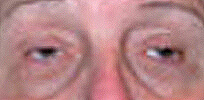 |
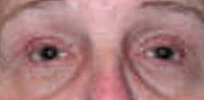 |
| Before | After upper lid ptosis repair and blepharoplasty |
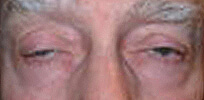 |
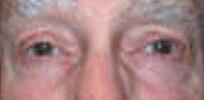 |
| Before | After upper and lower lid blepharoplasty |
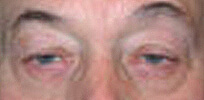 |
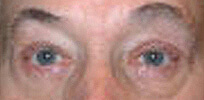 |
| Before | After upper lid ptosis repair |
 |
 |
| Before | After upper lid ptosis repair |
 |
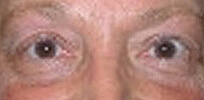 |
| Before | After upper lid ptosis repair |
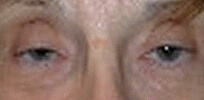 |
 |
| Before | After upper lid ptosis repair |
Muscular - In some people ptosis is actually caused by a weak levator muscle. The function of the levator muscle is to raise the eyelid. Muscular ptosis can occur in early childhood or adulthood.
Ptosis which occurs in early childhood is usually due to a weak levator muscle. If the ptosis affects the child's vision, early correction is necessary. In some cases the ptosis will actually keep a child from walking well because the child must lift the chin in order to see. If the ptosis is not that severe, ptosis repair is usually delayed until the child is more cooperative, between 4 and 6 years of age. Mild ptosis in childhood can worsen as the person ages, requiring surgical repair in young adulthood.
Muscular ptosis can also be acquired later in life as the muscle weakens. In some cases, muscular ptosis is associated with other muscular or neurologic problems.
If some muscular function remains in the levator muscle, muscular ptosis is corrected by actually tightening the levator muscle (levator resection). When the muscle is first tightened you will not blink normally. This may result in dryness of your eye. At first, you will need to frequently lubricate your eye with ointment and/or drops in order to keep the eye from drying out. With time you should be able to close your eye normally.
If the levator muscle is very weak, tightening the muscle will not adequately raise the lid. In that case a frontalis suspension is necessary. During a frontalis suspension, small strands are placed between the eyelid and eyebrow. These strands are tightened in order to raise the lid. When you wish to raise your eyelid you will unconsciously raise your brows. When you want to close your eyelids you will unconsciously lower your brows and squeeze your eyelids shut.
In children, a frontalis suspension is performed with fibrous tissue taken from the leg, either your child's own leg or a donor. This usually produces a long-lasting correction, although adjustments later in life are often necessary.
In most adults, a frontalis suspension is performed with an elastic strand of solid silicon. The silicon strand is more elastic than the fibrous tissue used in children, making it easier to close your eyelids after the procedure. In addition, using the silicon is safer because the eyelid height may easily be lowered if your eye is drying out and cannot tolerate the higher position of the eyelids.
After Surgery
After surgery, your eyelid will be swollen and your vision will be blurry. It is important to elevate your head and use cold compresses as much as possible after surgery to reduce the swelling. If the swelling is excessive it could stretch the sutures and cause the eyelid to droop again.
After surgery, the operated eyelid will be stiffer than normal. When you go to sleep and your facial muscles relax, your eyelid will tend to open slightly. In general, the weaker the lifting muscle was before surgery the more stiffness will be produced by surgery. However, it is necessary to use lubricating ointment and/or drops to prevent dryness. In most people these lubricants will be needed for a few weeks after surgery.
Some people are at risk of serious drying of the eye. Serious dryness may occur in people who already have eye disease or dry eyes. Serious dryness also occurs in people who have difficulty protecting their eye, such as those people with weak facial muscles or poor movement of their eyes. Your doctor will discuss how to lubricate your eye properly.
You will see the doctor one week after surgery to ensure that your eye is adequately lubricated. You will need to see the doctor regularly until you can close your eyelid well.
Adjustment
Unfortunately, ptosis repair is not an exact science. The final position of the eyelid depends on the healing of the tissue. In some cases, later adjustment is necessary. If the eyelid is clearly too high or too low at the first visit the wound is gently opened in the office and the eyelid height readjusted.
At other times, the adjustment will be performed several months after surgery if the eyelid height is not appropriate. Performing an adjustment after the tissue has healed requires a second surgery.
Contact Lens Wear
You may resume wearing contact lenses when your eyelid is closing well and your eye feels comfortable. Most people begin wearing lenses again about three to four weeks after surgery. Rigid contact lens wearers may have some difficulty removing the lenses initially.
A small minority of people have difficulty tolerating their lenses after surgery, as their eye may feel dryer.
Glasses
In some cases you may need to update your eyeglass prescription after surgery. You should wait until at least two months after surgery before being examined for your new eyeglasses.
Risks
The risks of ptosis surgery include:
- Unusual bruising or swelling after surgery
- Infection
- Need for adjustment or additional surgery
- Asymmetric eyelid height
- Overcorrection or undercorrection
- Dry spots requiring lubricants
- Stiffness of the eyelid in downgaze
- Need to have the eyelid lowered if intolerant of having the eyelid opened
Not every condition is listed. Consult Dr. Goldberg or Dr. Lippe if you have any questions about a condition not described here.
Find a Doctor
Physician information including education, training, practice location and more.
Schedule an Appointment
Call 800-762-7132 or make an appointment online.





